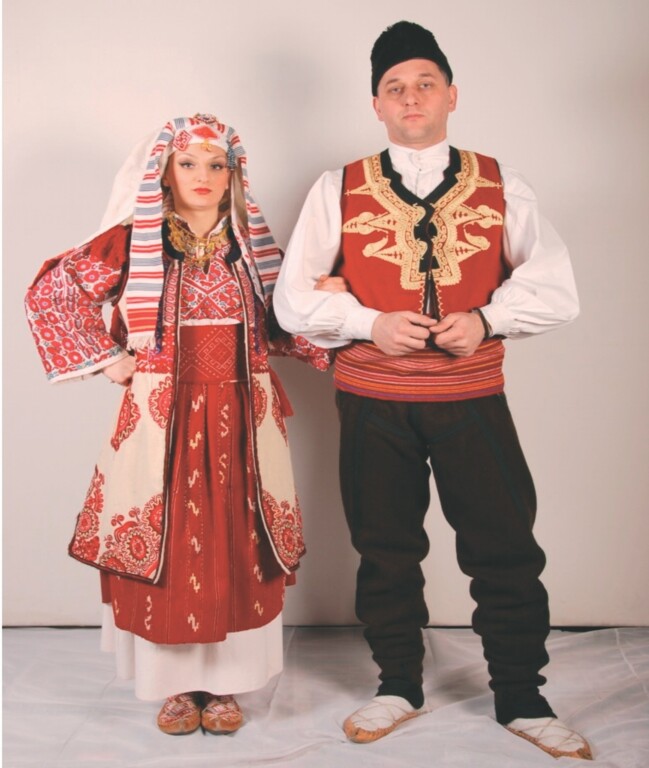Serbian clothing pattern in Peć,
late 19th and first half of the 20th century
In all regions of the Central Balkan zone, both in women's and men's clothing, a linen shirt in the form of a straight-cut tunic with sleeves was the basic lower and upper garment. Originating from ancient times, used among the Illyrians, Thracians, Dacians, and Slavs, it was typically wide, with one to two side wedges. (Serbian National Costumes in Kosovo and Metohija in the 19th and 20th centuries. Belgrade, Leposavić, Museum in Priština, Mnemosyne, KUD "Kopaonik", 2013. Pp. 16-19.)

In the Raška-Metohija-Kosovo belt, it developed into a bell-shaped garment with more inserted wedges, with brides having up to twenty. In this form, with rich embroidered decoration, reflections of medieval textiles of Serbian feudal robes are visible.
Women's costumes are defined by a skirt made of two transversely assembled parts, pleated and open along the entire length. It was equally worn by girls, brides, and married women. The two main variations are a short skirt, covering only the hips or reaching the knees, decorated with woven geometric patterns - zaprega, narebrnica, bokča, bošča, bojče, in Raška-Metohija-Kosovo costumes, and a long skirt, reaching almost to the hem of the shirt, striped weaving, with names - futa, futarka, vuta, vutara, zaprega (from Southern Pomoravlje, across Resava and Svrđig all the way to the Timok regions).
Archaeological material from the Roman period with preserved traces of the old Balkan tradition of the autochthonous population suggests to some scholars an analogy between the short skirt zavijača and a similar old Balkan clothing form.

The most beautifully shaped garment with wide application, known over a wide area from the south of the Balkan Peninsula through northeastern Europe to front and central Asia, is the zubun made of white wool, sleeveless, knee-length, open at the front. Metohija zubuni are distinguished by the relief of subtly arranged geometric patterns. Along with inevitable geometric decorations, stylized floral motifs are represented, executed with embroidery, appliqués of čoja, and the addition of tassels and fringes.
It was an integral part of the clothing of the Thracians, Illyrians, and Slavs, and specimens from the 19th and 20th centuries testify to the high achievements of folk craftsmanship, later influenced by Byzantine, Serbian medieval, Western European, and decorative values.

The long white uncut or cut woolen gown with sleeves, sukno, of old Slavic origin, was known in certain periods from southern Balkans to northern Europe. Probably adopted from shepherds who penetrated here from Asia, it is most common in eastern regions.


Among the upper parts of clothing worn in summer, and some mostly only in winter, the short vest, jelek, jeleče, gunjić, had a wide application and distribution. Arising from the transformation of zubun in the Turkish period, jelek is a sleeveless garment that has persisted to this day.

Čakšire represents a clothing item subject to many influences, which have not affected its name. Under Turkish-Oriental influence, they were cut with a tura and narrow legs from the knee, and in the Metohija tradition, they are found in the form of deeply cut trousers, the width adapted to the need for movement during daily work. Made of dark woolen fabrics, they reflected the wealth of the owner with the richness of decorations made of sewn black braids.

Instead of a conclusion, let's quote a story by Danilo Nikolić from the collection "Return to Metohija": (Danilo Nikolić: Return to Metohija. Belgrade, Slovo Ljubve, 1973. 129 pages. (Contemporary Yugoslav Short Story) Pristina, Jedinstvo, Belgrade, Serbian Literary Cooperative, 1991. 285 pages. (Serbian Storytellers)) "Perhaps in Metohija there was what will always be necessary for us. The further in time, the more, the more necessary. Something calm, eternal, fruitful, lush, peaceful. How we lost somehow imperceptibly, gently inevitably what we will never have again... Metohija is our childhood, our youth, our purity. That's why we should live and hope for a 'return to the origin.'
Working in this field was a special pleasure, because we all really wanted to perform in that place. In front of the Patriarchate of Peć, in an Albanian environment, about fifty Serbian young men and women played and sang the song Gde si bila Nedo, Nedo čanaklijo? Ja sam bila, proto, u mitropoliju! At the time this song was created, the Patriarchate of Peć was a metropolis and the song refers to it.

The opportunity to play a dance in the Visoki Dečani Monastery, which was performed 150 years earlier in the courtyard of the Patriarchate of Peć, and to sing "Igralo kolо pod Vidin, pusti mene majko da vidim and it is seen to Gorazdevac, the borders and gates of Metohija, and all this in the national costumes of this region, provides a spiritual rebirth and fulfillment.
These moments were shared with us, among others, by Father Mihajlo and Father Slobodan from the Raška-Prizren Diocese, brave people and faithful guardians of Serbian cultural heritage.

